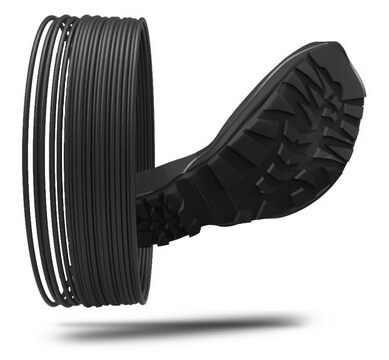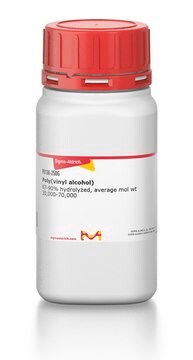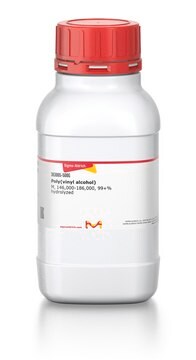おすすめの製品
詳細
Filament diameter: 2.85 ± 0.10 mm
Filament roundness: ≥95%
Melt flow rate: 14-20 g/10 min
Melt temperature: ± 163 °C
Print temperature: ±180-205 °C
Specific gravity: 1.23 g/cc
Spool hub diameter: 52 mm
Spool size (D x H): 200 mm x 55 mm
Viscat softening temperature: ± 60.2 °C
形状
solid (filament)
色
colorless
InChI
1S/C2H4O/c1-2-3/h2-3H,1H2
InChI Key
IMROMDMJAWUWLK-UHFFFAOYSA-N
類似した製品をお探しですか? 訪問 製品比較ガイド
詳細
Polyvinyl alcohol (PVA) printing filament is a water-soluble support material for multi-extrusion 3D printing of complex architectures. PVA is widely used in traditional industries, such as textiles and papermaking, as well as a wide variety of coatings. This colorless, odorless, and high-quality filament extrudes between 180 to 205 °C and is suitable with all RepRap technology-based desktop 3D printers, such as MakerBot, Ultimaker, RepRap (Mendel, Huxley, Prusa), UP!, Solidoodle, Leapfrog, etc. PVA features good adhesion to PLA and nylon materials and is biodegradable in water with no hazardous by-products. While PVA is soluble in cold water, the dissolution process can be accelerated by using a continuously heated bath of warm water. When not in use, the filament should be stored at room temperature in dry conditions, such as in a sealed plastic bag or in a closed container with desiccant. Recommended initial printer settings can be found in the ′General Print Settings′ file.
アプリケーション
Due to its water-solubility and biocompatibility, polyvinyl alcohol (PVA) filaments are most commonly used as a sacrificial material in the formation of tissue engineering constructs with unique and complicated architectures. The use of this material allows for the printing of scaffolds with large overhangs, deep internal cavities, and/or intricate geometries. In addition to their use as sacrificial materials, PVA filaments have also been used to print novel oral drug delivery devices and tablets.
法的情報
Product of Formfutura VOF
AquaSolve is a trademark of Formfutura VOF
保管分類コード
11 - Combustible Solids
WGK
WGK 1
引火点(°F)
49.5 °F
引火点(℃)
9.7 °C
適用法令
試験研究用途を考慮した関連法令を主に挙げております。化学物質以外については、一部の情報のみ提供しています。 製品を安全かつ合法的に使用することは、使用者の義務です。最新情報により修正される場合があります。WEBの反映には時間を要することがあるため、適宜SDSをご参照ください。
労働安全衛生法名称等を表示すべき危険物及び有害物
名称等を表示すべき危険物及び有害物
労働安全衛生法名称等を通知すべき危険物及び有害物
名称等を通知すべき危険物及び有害物
Jan Code
901031-1EA:
901031-VAR:
901031-BULK:
901031-1EA-PW:
最新バージョンのいずれかを選択してください:
この製品を見ている人はこちらもチェック
Alice Melocchi et al.
International journal of pharmaceutics, 509(1-2), 255-263 (2016-05-25)
Fused deposition modeling (FDM) is a 3D printing technique based on the deposition of successive layers of thermoplastic materials following their softening/melting. Such a technique holds huge potential for the manufacturing of pharmaceutical products and is currently under extensive investigation.
Shuai Li et al.
ACS applied materials & interfaces, 8(38), 25096-25103 (2016-09-09)
Despite considerable advances in tissue engineering over the past two decades, solutions to some crucial problems remain elusive. Vascularization is one of the most important factors that greatly influence the function of scaffolds. Many research studies have focused on the
R Hernández-Córdova et al.
Journal of biomedical materials research. Part A, 104(8), 1912-1921 (2016-03-19)
Biomaterial scaffolds are a key part of cardiac tissue engineering therapies. The group has recently synthesized a novel polycaprolactone based polyurethane-urea copolymer that showed improved mechanical properties compared with its previously published counterparts. The aim of this study was to
Tatsuaki Tagami et al.
Biological & pharmaceutical bulletin, 40(3), 357-364 (2017-03-03)
Three-dimensional (3D) printers have been applied in many fields, including engineering and the medical sciences. In the pharmaceutical field, approval of the first 3D-printed tablet by the U.S. Food and Drug Administration in 2015 has attracted interest in the manufacture
Soumyaranjan Mohanty et al.
Materials science & engineering. C, Materials for biological applications, 55, 569-578 (2015-06-29)
One of the major challenges in producing large scale engineered tissue is the lack of ability to create large highly perfused scaffolds in which cells can grow at a high cell density and viability. Here, we explore 3D printed polyvinyl
ライフサイエンス、有機合成、材料科学、クロマトグラフィー、分析など、あらゆる分野の研究に経験のあるメンバーがおります。.
製品に関するお問い合わせはこちら(テクニカルサービス)









